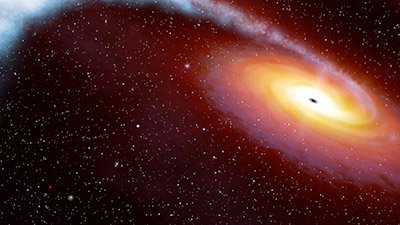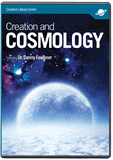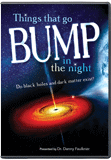
Black Hole Raises Questions About the Early Universe
Big black hole and its bright quasar raise questions about the early universe.
News Source
In an effort to learn about the universe’s earliest days, astronomers with the UKIRT Infrared Deep Sky Survey have been searching for objects with large redshifts. Redshifts represent the stretching of light waves emitted by objects. In the case of distant galaxies, redshifts are thought to be caused by the expansion of the universe. According to the Hubble Law, a large redshift corresponds to a very great distance. The Survey has found the most distant bright object yet discovered.
Designated ULAS J1120+0641, the object is a very bright quasar. This quasar is not the most distant object yet found. That distinction belongs to a gamma ray burst. But ULAS J1120+0641 is the farthest object bright enough to be studied in some detail.
Quasars are distant galaxies. A quasar looks so bright because it releases enormous amounts of energy from its core. The core is thought to contain a massive black hole. Black holes are invisible. But as material gets pulled into a huge black hole, the matter is heated, releasing tremendous energy, which is visible from earth. And this newly discovered quasar is even brighter than most because the black hole at its center is exceptionally massive.
Therein lies the problem. Because some cosmologists believe distant light takes billions of years to reach earth, they believe light from this bright quasar which is 12.9 billion light-years away actually took 12.9 billion years to get here. If that were true and if the big bang had really happened, then looking at the quasar would be like looking backward in time to see what the universe looked like when it was 770 million years old.
The big bang idea demands that time elapse for massive objects like that to form, and 770 million years just isn’t enough time.
But this black hole has “a mass two billion times that of the Sun.” The big bang idea demands that time elapse for massive objects like that to form, and 770 million years just isn’t enough time. Chris Willott of the Canadian Astronomy Data Centre commented, “It is safe to say that the existence of this quasar will be giving some theorists sleepless nights.”
Alternative explanations for light-travel-time eliminate the idea that astronomers are peering back in time and instead suggest that the quasar with the big black hole is just very, very far away. The big bang model not only disagrees with the Bible’s account of the origin of the universe (for the Scriptures teach the earth came before the Sun) but also has a number of other astrophysical problems. This big black hole just added one more to the list.
Further Reading
For More Information: Get Answers
Remember, if you see a news story that might merit some attention, let us know about it! (Note: if the story originates from the Associated Press, FOX News, MSNBC, the New York Times, or another major national media outlet, we will most likely have already heard about it.) And thanks to all of our readers who have submitted great news tips to us. If you didn’t catch all the latest News to Know, why not take a look to see what you’ve missed?
(Please note that links will take you directly to the source. Answers in Genesis is not responsible for content on the websites to which we refer. For more information, please see our Privacy Policy.)
Recommended Resources

Answers in Genesis is an apologetics ministry, dedicated to helping Christians defend their faith and proclaim the good news of Jesus Christ.
- Customer Service 800.778.3390
- © 2024 Answers in Genesis





